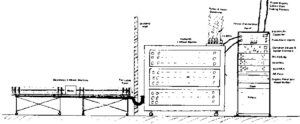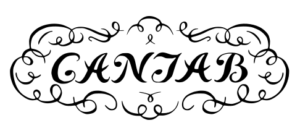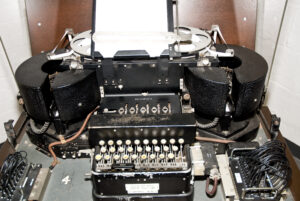BOMBE TYPES
We can consider first the machine types that went into volume production. The number after each type is the total number recorded as manufactured and delivered. These numbers, however, must be viewed with a little caution because some machines were known to have been returned to Letchworth for refurbishment and modification.
- Early 3 wheel 30 Enigma (Pre-production)
- Early 3 wheel 36 Enigma [73]
- 4 Wheel 36 Enigma (BTM – High Speed) [57]
- 4 Wheel 36 Enigma (GPO/BTM) – Cobra [12]
- Later 3 wheel 36 Enigma (High Speed Siemens type sense relays) [69] Our Target Machine
- Various special machines and attachments
MACHINE TYPES (3 Wheel)
Please note : not all the technical points made below have been fully verified.
As a point of interest, these machines with the exception of the Click machine are all virtually the same size. The depth is 24″ [600mm] over the covers, 28″ [700mm] over the foot castings and 32″ [800mm] over the Castors. The overall height is 78″ [2000mm] with the castors still fitted (which was the normal case except very early machines). The length of the early versions was 84″ [2134mm] and the later ones were 88″ [2250mm] not including the plugboard frames protruding about 3″ [80mm] at the left end of the machine. The difference in length was due to the standardisation of the frame somewhere around mid-1943 to suit both 3 and 4 wheel BTM machines. A heavy right-hand end extension was welded to the frame to support the 36 ‘very fast’ wheels. This frame was retained on the later 3 wheel machines with the input switches and indicator panel etc being fitted directly to the new heavy section.
39 POINT [6502/2]
This version is the first to be produced in volume. It used BTM ‘A’ type relays for the sense circuits.
BASIC 39 POINT
This is the version that appears in the photographs first available to the BP Trust. Our research is concentrated on this machine. This model uses Siemens high-speed relays in a bridge circuit for its sensing logic.
BASIC 30 POINT
The main difference between this and the 39 point type is that only 4 point times are used to perform the carry on the middle and where appropriate the bottom sets of wheels. The 39 point took 26 characters/points + for 13 points for the carry. Hence, the 30 point was faster than the 39 point. The speed increase was mainly due to extra gearing on the carry cams shafts and by having ‘sharper’ carry cams which moved the carry mechanisms quicker.
JUMBO
This is similar to the basic machines but is specifically designed to work with weak menus. According to Engineers who worked on them, they did not have the indicator unit fitted to the right end of the machine. They did, however, have an electric typewriter on which was recorded a list of possible ‘stops’. Post Office type Uniselectors were used to recover stop information from around the machine and direct this to the typewriter one character at a time. The noise made by all the Uniselectors turning in synchronism sounded a little like a ‘machine gun’ and this term was used to describe the scanning process.
GIANT [and OGRE]
The first manifestation appears as four basic “standard” Bombes bolted together on massive girders. Special mechanical and electrical connections were made to make the four operate as one complete massive machine. The 3 wheel version did not stay together for long and was soon reconfigured as four separate standard 3 wheel machines.
Later four 4 wheel BTM (High-Speed Keen) machines were linked together. This assembly stayed in Letchworth. It ran there from around June 1944 until early 1945 in a secure area under the direct control of Bletchley Park. This machine was called the Giant. There was at one time a two machine configuration named Ogre,
CLICK or CLIQUE
Research so far has only uncovered that this machine had only the right-hand end of eight Enigmas i.e. The right-hand wheel and the stecker. Punched cards containing part of a Crib were then read into the machine and run against the wheel positions. We have recently discovered that we have drawings which match these specifications and these will be investigated further in due course.
FUNF or TWINN
There were two of these machines specially adapted so that the bottom bank of twelve enigmas were used as “very slow” wheels.
It is thought that the bottom bank’s middle row provided the “very slow” wheels for the top bank, whilst its bottom row provided the “very slow” wheels for the middle bank.”
Thus creating a type of four-wheel machine albeit a very slow version with just 24 Letchworth Enigmas available. An extra electro-mechanical indicator “drum” was added on the front of the machine. This can be seen on a photograph which is often used in publicity etc.
Other changes such as nine sense circuits were featured as they were specifically designed to attack Abwehr coding
OTHERS
The list above is not yet complete. Other types include Universal, O.C.C. Universal Drive etc. These still have to be explored.
An IBM typewriter was normally attached to the High Speed Keen, 4 wheel BTM machines.
ATTACHMENTS
BTM FOURTH WHEEL ATTACHMENT
This is not the same as the powered “attachment” referred to below. It is a free-standing unit on its own castors. It has no power but allowed a further set of 36 drums to be connected into the menu. We have a full set of drawings from which we are able to produce a brief technical description. There are photos showing these in bays at Eastcote and other outstations but none appear to be in use. However, there is evidence that a similar attachment was produced called a ‘PLUGGABLE UMKEHRWALZ or GROUPED UMKEHRWALZ (GUW). This did not have drums but instead had 36 pairs of 26 way jacks into which linking cables could be plugged.
FILIBUSTER
Two engineers have separately referred to this attachment but details have not yet emerged.
DUDBUSTER
Another attachment yet to be investigated.
4 WHEEL MACHINES
As stated previously we have no plans to produce a 4 wheel bombe, however, there is a lot of interest in the subject so we are investigating the various models for technical interest reasons plus the fact that this often provides clues to earlier machines. The list is as follows
W W
In some respects, the basic section of this machine is similar in construction to the Jumbo in that it does not have the indicator unit or various other features fitted. It is almost certain that W W stands for Wynne-Williams, who devised the first version of a British 4 wheel Bombe. His attachments were connected to this version of a BTM bombe. This leads us to the “Cobra” machine which David Whitehead C.Eng. MIEE has written up and published in detail.
To the BTM section of the COBRA are attached the Mawdsley units. In these, commutators and carbon brushes act as the fourth, very fast wheels. Wired reflector cables were plugged into sockets on the frame. A “Flowers/GPO” sensing unit completed the setup. Apparently, the GPO sensing unit was first tested successfully on a standard BTM Bombe. However, a report written at the time suggests that the BTM sensing system fitted with the new small Siemens type relays were fast enough to keep up with anticipated speed increases and this indeed proved to be the case.

GPO SENSING UNIT
Seen on the right of the above image
(Reproduced with the kind permission of David Whitehead C.Eng MIEE)
We have no detailed drawings of this unit other than the related sense pulse amplifying cabinet containing 33 off type 807 thermionic valves, which was mounted on top of the BTM Bombe. We have little detailed information about the much more complex GPO designed and produced unit but we do have fragments of information kindly supplied to BP by GCHQ together with other related information recorded by ex GPO engineers. It is our hope that all this information will be brought together in one place sometime in the near future so that further research can be carried out.
BTM 4 WHEEL (High Speed Keen) BOMBE or FOURTH WHEEL (POWERED) “ATTACHMENT”
Photographs have been tracked down recently but prior to that one of the RAF engineers had produced a sketch, which has turned out to be very accurate, and this is confirmed in three photographs. Prior to the photos arriving, we had already located in the drawings some very heavy vertical and horizontal shafts. From there, we had been able to determine the spacing of the 4 x 9 very fast fourth drums. Further research, which continues in December 2017, shows that the very fast drums were driven by two motors. The right-hand end of this machine is deeper than the original at around 30″. With all the additions, the BTM 4 wheel machine looks rather untidy. We have yet to establish if there is any direct mechanical connection and it is thought that the very fast drums may have run only ‘semi-synchronised’ with the rest of the machine. This presents us with a similar problem to that found on the COBRA machine and demands more investigation.
HIGH SPEED [4 WHEEL]
These were speeded up versions of the basic machine BTM machines with the 36 very fast wheel added at the right-hand end. One version, see below, used large thermionic valves in the sense pulse generation circuits. We understand that this not only lowered the impedance of the pulse generation circuit but also eliminated the poor waveforms which the mechanical circuit breakers produced when their contacts ‘bounced’.
BTM VALVE CABINET
We heard of this first from the RAF engineers but it was later that we were fortunate to obtain a photograph. This unit stood on the top of a 4 wheel Bombe at the left-hand end. The dimensions are, height 37″ [950mm] width 20″ [500mm] depth 24″ [600mm]. It contains 4 valves, 2 type GT1C Thyratrons and 2 type FG 41. The latter pair are very large with a glass bulb about 12″ [30mm] long and 2″ [50mm] in diameter. At the centre, the glass expands to a sphere of about 5″ [120mm] diameter. All we know about this valve’s characteristics at present are that it had 5V heaters. These are almost certainly valves (tubes) called Excitron or Exitron. One of the senior RAF engineers tracked these down some years ago as being manufactured by GEC Kidsgrove. GEC was apparently manufacturing them for Marconi.
There appears to have been two versions of the valve cabinet depending on whether a single or double input was applicable. One interesting component in this cabinet is a “dissipator lamp”, a 1 amp version being used for single input and a 4 amp version for double. We would like to know more about these devices. Could they be similar to a Barretter? Any ideas would be appreciated.
As stated above the valve cabinet was designed to produce a very clean and low impedance sense pulse. One thyratron created the start of the pulse and the other quenched it. Presumably, the large valves supplied the high currents involved.
NCR AMERICAN NAVY BOMBE
This 4 wheel Bombe is similar in general principles to the British bombe but very different in detail. It was a totally new design produced in the USA by NCR. Please note that in many publications produced by professional organisations such as the Imperial War Museum and the IEE, a photograph is reproduced of the American Bombe and then captioned the British Bombe. This error has propagated itself into many recent publications and causes a great deal of confusion. One of these machines still exists at the National Security Agency Museum on the outskirts of Washington DC. It is thought that this machine is capable of being connected with its power supplies and run.
AMERICA ARMY BOMBE
Details to be added
OTHER BTM EQUIPMENT
TYPEX MODIFICATIONS
Amongst the original Bombe drawings returned from GCHQ we found BTM drawings of small plugboard assemblies. Initially, we thought that these were for use on a Bombe but after further study, it became clear that these were used to modify Typex Machines. These plugboards allow steckering and more flexible reflector use than the basic Typex allows. We have built these with extra removable parts to enable us to run a Typex as an Enigma.
PUNCHED CARD RELATED MACHINES
What is also emerging is that there were a significant number of specially modified types of punched card equipment delivered to Bletchley Park. Some of these units were attached to Bombes but many more were free-standing. These will have to be researched when time is available if the full picture of BTM’s involvement in codebreaking is to be discovered and recorded.

